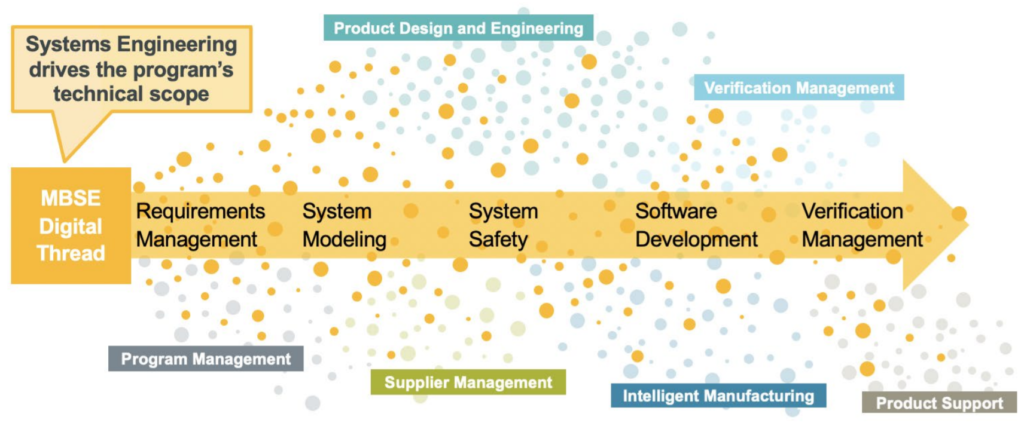Updating MBSE for a new aerospace industry

Aerospace and defense companies and the wider industry are experiencing an exciting period of innovation, one which has been accelerated by an emphasis on environmental sustainability. For many of these innovations, there is increased complexity and challenges to development. That complexity, and the challenges that follow, could come from the integration of more electrical control systems to complete redesigns of aircraft for next generation propulsion. Regardless of the problem, it is likely to fall into at least one of the following trends, and if it does Model-Based Systems Engineering (MBSE) may be the answer to those woes.
Pressure to reduce program cost and schedule: Too many programs today in the aerospace industry are over budget, late or both. Successful companies are no longer just bending the cost curve, they are breaking it
Increased program complexity and integration: That complexity requires greater software integration, encompassing software electronics and mechatronics domains. These requirements are compounded when certifying new products and bringing them to market.
Increased electrification of products: Electrical and alternative propulsion systems will require even more software integration, adding yet another level of complexity. Even without adopting new propulsion, many companies are replacing mechanical controls with electrical ones to improve reliability and maintainability.
Globalization: Much like the automotive, more aerospace systems are being produced in a global supply chain. Meeting that, with increased system complexity, will require effective management of suppliers and the workforcedistributed around the globe.
Tomorrow’s aerospace industry needs to be better, more reliable, more sustainable and more complex, and it needs to meet that challenge faster with less production and maintenance cost to compete with agile start-ups. But how will MBSE resolve these needs? A digital thread to connect and guide all domains.
Many may question, hasn’t aerospace already implemented systems engineering, or even model-based systems engineering? This is correct, the industry even pioneered many of the concepts still used today, but these practices rely on a document-centric communication system. As aerospace designs and projects become more complex, a document-based approach will hamper program times, allow mistakes to persist until late-stage production and increase lead-times for supplier relationships. A new MBSE, focused on integrating diverse development domains will help companies:
- Orchestrate technical programs by using models to define product architecture and requirements.
- Enable the Comprehensive Digital Thread and create a digital enterprise for multi-domain development.
- Manage complex product and Supply Chain integration, eliminating integration issues earlier in the design process.
- Perform Performance Monitoring to reach full product visibility throughout the lifecycle.
With the customizability of an MBSE methodology, no two implementations are the same. There are a handful of common practices that any company can implement today – define your system of systems in your model, explore your design space (with multi-disciplinary design optimization), test the systems virtually before you build and trace requirements from concept to maintenance.

There is so much more to learn about how MBSE can accelerate your development processes, for more information take a look at this eBook on MBSE for aerospace. However you plan to accelerate your product development to become more agile and efficient, Siemens’ Model Based Systems Engineering digital thread is here to help, as a part of the Xcelerator portfolio.
Siemens Digital Industries Software is driving transformation to enable a digital enterprise where engineering, manufacturing and electronics design meet tomorrow.
Xcelerator, the comprehensive and integrated portfolio of software and services from Siemens Digital Industries Software, helps companies of all sizes create and leverage a comprehensive digital twin that provides organizations with new insights, opportunities and levels of automation to drive innovation.
For more information on Siemens Digital Industries Software products and services, visit siemens.com/software or follow us on LinkedIn, Twitter, Facebook and Instagram.
Siemens Digital Industries Software
– Where today meets tomorrow


